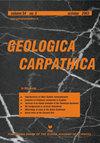高特拉山含硅线石质变质岩的部分熔融作用与Th-U-Pb定年
IF 1.5
4区 地球科学
Q4 GEOSCIENCES, MULTIDISCIPLINARY
引用次数: 1
摘要
西喀尔巴阡山脉的塔特拉山脉是研究中欧阿尔卑斯-喀尔巴阡造山带内瓦里斯坎基底东延的关键区域。变质带显示了一个反向变质序列,与瓦里斯坎逆冲作用和片麻岩、混辉岩和花岗岩在云母岩上的侵位有关。本文介绍了高特拉期含硅线石质变质长质片麻岩、混辉岩和花岗闪长岩中独一石Th-U-Pb定年的新结果,以及基于热力学模型的岩石学解释。变质片麻岩为石榴石+硅线石+斜长石+黑云母+白云母+钛铁矿+石英的变质峰组合;石榴石岩心中金红石、腐殖白云母和paragonite包裹体表明其变质阶段较早。热力学模型表明,在地壳中部,从6kbar以上到约5-6 kbar和650-700°C,顺时针、顺时针、顺时针的P-T路径是由星沸石-硅线石序列反应形成的。在地壳下部减压过程中,以钾长石、斜长石(An12-35)和石英为主的混合岩在7-8 kbar和760-770°C的温度下发生了部分熔融反应,形成了包晶、富锰石榴石和/或钛磁铁矿。变长岩片麻岩中的独居石组成与混辉岩中的白色小体不同。后者显示出明显的eu负异常,解释为与长石共结晶的结果,较高的Y含量表明结晶温度较高。单方石的年龄在2σ误差范围内一致,表明早石炭世(350 ~ 345 Ma)发生变质和熔融作用,是瓦立斯坎造山过程中大陆碰撞和地壳增厚的结果。本文章由计算机程序翻译,如有差异,请以英文原文为准。
Variscan metamorphism and partial melting of sillimanite-bearing metapelites in the High Tatra Mts. constrained by Th–U–Pb dating of monazite
The Tatra Mountains of the Western Carpathians are a key area for the study of the eastern continuation of the Variscan basement within the Alpine–Carpathian orogenic belt in Central Europe. Metamorphic zonation in the Tatra Mts. displays an inverted metamorphic sequence related to Variscan thrusting and emplacement of gneisses, migmatites and granites over micaschists. Here we present new results of Th–U–Pb dating of monazite in sillimanite-bearing metapelitic gneisses, migmatite and granodiorite from the High Tatra along with petrological interpretation based on thermodynamic modelling. The metapelitic gneisses show the peak metamorphic assemblage garnet + sillimanite + plagioclase + biotite + muscovite + ilmenite + quartz; inclusions of rutile, phengitic muscovite and paragonite in the garnet core indicate an earlier metamorphic stage. Thermodynamic modelling suggests a clockwise, prograde P–T path via staurolite-to-sillimanite sequence reactions from above 6 kbar to ca. 5–6 kbar and 650–700 °C, at mid-crustal levels. Migmatites, with dominant K-feldspar, plagioclase (An12–35) and quartz in the leucosome, underwent partial melting involving biotite dehydration reactions and formation of peritectic, Mn-rich garnet and/or Ti-magnetite at ca. 7–8 kbar and 760–770 °C, during decompression from lower-crustal levels. Monazite composition in metapelitic gneisses differs from that in leucosome of migmatite. The latter shows pronounced Eu-negative anomalies interpreted as the result of co-crystallization with feldspars and higher Y contents indicating higher temperature of crystallization. Monazite ages are identical within 2σ errors and indicate that both metamorphic and melting events occurred in Early Carboniferous, between 350–345 Ma as a consequence of continental collision and crustal thickening in the course of the Variscan orogeny.
求助全文
通过发布文献求助,成功后即可免费获取论文全文。
去求助
来源期刊

Geologica Carpathica
地学-地球科学综合
CiteScore
2.40
自引率
23.10%
发文量
26
审稿时长
>12 weeks
期刊介绍:
GEOLOGICA CARPATHICA covers a wide spectrum of geological disciplines including geodynamics, tectonics and structural geology, volcanology, stratigraphy, geochronology and isotopic geology, karstology, geochemistry, mineralogy, petrology, lithology and sedimentology, paleogeography, paleoecology, paleobiology and paleontology, paleomagnetism, magnetostratigraphy and other branches of applied geophysics, economic and environmental geology, experimental and theoretical geoscientific studies. Geologica Carpathica , with its 60 year old tradition, presents high-quality research papers devoted to all aspects not only of the Alpine-Carpathian-Balkanian geoscience but also with adjacent regions originated from the Mediterranean Tethys and its continental foreland. Geologica Carpathica is an Official Journal of the Carpathian-Balkan Geological Association.
 求助内容:
求助内容: 应助结果提醒方式:
应助结果提醒方式:


